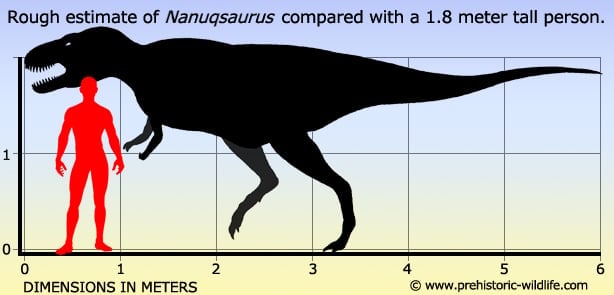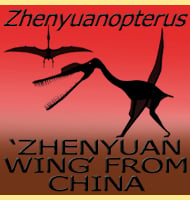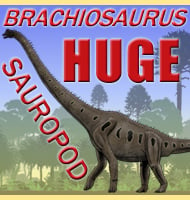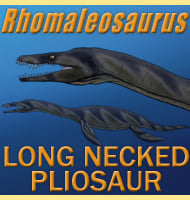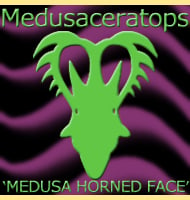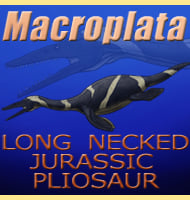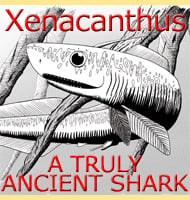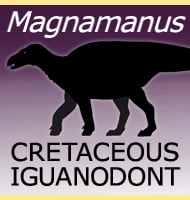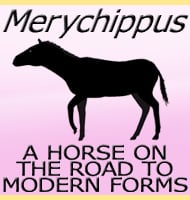In Depth
Back in the Cretaceous North America was divided into two land masses due to the presence of the Western Interior Seaway, a shallow sea that submerged the central portions of North America all the way from Canada to Mexico. These two land masses were Appalachia in the east, and Laramidia in the west, and with the Nanuqsaurus holotype fossils coming from Alaska, we know that this tyrannosaur lived in northern Laramidia. This is considerably further north than many of the more famous and larger North American tyrannosaurs, which has led to a lot of sudden interest about Nanuqsaurus.
Because Nanuqsaurus seem to have lived so far north, they would have lived in a much colder environment than that experienced by the Southern tyrannosaurs. This in turn has led to the suggestion that Nanuqsaurus may have had at least a covering of insulatory feathers over its body in order to better survive this environment. There is no direct fossil evidence that proves that Nanuqsaurus had feathers, but the discovery of Yutyrannus in China, and also interpreted as living in a cool environment, proves that at least some of the larger tyrannosaurs were feathered all over.
If Nanuqsaurus spent most of its time living in the region were the holotype was found and was not merely passing through, then these tyrannosaurs would have experienced a greater seasonal variation that other tyrannosaur genera living further south. This variation could include extended periods of daylight in summer months, and extended periods of darkness in winter months. This may have also brought about a seasonal availability of prey with dinosaurs such as ceratopsians and hadrosaurs moving further north to feed upon fresh plant growth in summer, then migrating further South in winter.
Because of the incomplete state of preservation for the holotype remains, only a best guess is available for the size estimate of Nanuqsaurus. This however does show that if the adult size was about six meters long, then Nanuqsaurus would have been relatively small for a tyrannosaur, especially a genera alive in the late Cretaceous. It is possible that the small size of Nanuqsaurus may have been a result of living in its environment, especially if prey resources were scarce. Also of interest is that other predatory dinosaurs of the region such as Troodon are known to have grown half as big again as their southern relatives. Gigantism is a surprisingly common method that animals adopt to cope with colder climates because the greater mass of their bodies offers more insulation for the internal organs, so the reduction in size for Nanuqsaurus again seems to be driven by the availability of food.
Although the skull of Nanuqsaurus is incomplete, is does show that Nanuqsaurus would have had a heightened sense of smell, perhaps proportionately even greater than that of Tyrannosaurus. This would suggest that smell was an integral part of the Nanuqsaurus survival method, but how is likely to further the scavenger debate about tyrannosaurs. A sense of smell could be used to track living animals that otherwise might not have been easy to spot in the polar gloom. In addition this sense of smell may have been used to sniff out carrion, or perhaps even the kills of Troodon which had exceptionally good eyesight and so were probably still able to hunt in the dark. Even though small at six meters, Nanuqsaurus was still much bigger than Troodon and so may have still been capable of driving them away from their kills. This is pure conjecture however, as a good sense of smell can serve both a predator and a scavenger. There is also a world of difference between opportunistic scavenging, something that most meat eaters do, and obligate scavenging which is when an animal only scavenges.
The partial remains of Nanuqsaurus were first thought to represent remains of either Gorgosauurs or Albertosaurus until they were finally realised to actually represent a whole new genus of tyrannosaur. Even though Nanuqsaurus was once thought to represent an albertosaurine tyrannosaur, it is now thought to be a tyrannosaurine, and phylogenetically be close to Tyrannosaurus, Tarbosaurus and Zhuchengtyrannus.
Further Reading
- A Diminutive New Tyrannosaur from the Top of the World. - PLoS ONE 9 (3): e91287. - Anthony R. Fiorillo & Ronald S. Tykoski - 2014.
